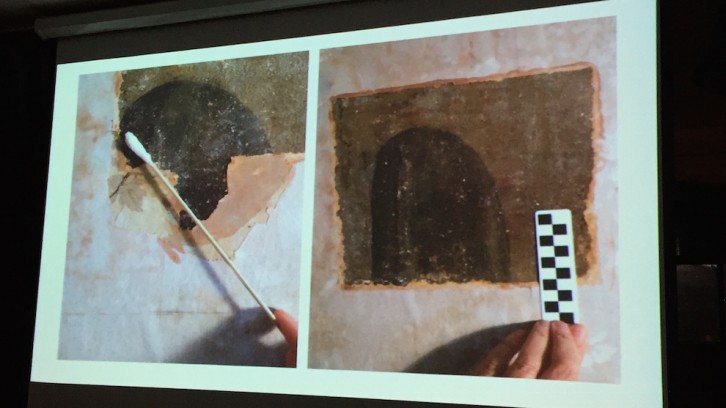N.S. heritage
A hidden painted room in Annapolis Royal is revealed
Heritage Trust of Nova Scotia brings art conservator, Ann Shaftel, to speak on the process of revealing a 175-year old hidden painted room

caption
Ann Shaftel, an art conservator, who is working to reveal hidden wall paintings in one of Canada’s oldest buildings.
caption
Ann Shaftel, an art conservator, who is working to reveal hidden wall paintings in one of Canada’s oldest buildings.A newly discovered early Acadian room in an Annapolis Royal inn is considered “the most important conservation project in all of Canada at the moment,” according to an art conservator working on the project.
Ann Shaftel, an art conservator, made the statement to a crowd of 37 people at the Nova Scotia Museum of Natural History, where a public presentation on the work took place on Thursday.
Shaftel holds advanced degrees in art history and art conservation. She also works nationally and internationally for museums, universities, governments, churches and private clients.
Shaftel was hired by the Annapolis Heritage Society in the summer of 2014 to examine the room and do some reveals. With further research, she concluded that the painted room is worthwhile and should be preserved and restored.
The Masons’ case
The paintings are hidden behind the room’s wallpaper in the 18th-century Sinclair Inn in Annapolis Royal, which is considered an early Acadian building.
“The paintings come from an English culture period, not an Acadian one. We are talking about two areas of cultural enrichment and potential source of tourist interest,” said Shaftel.
It is historically noted that the Masons had their earliest Canadian meetings in the building.
In one of the wall areas that Shaftel and her teams are examining, an “arch-like” image has been found. So if actual Masonic imagery gets revealed, then the Masons might have contributed to the project.

caption
Could this be an arch?Shaftel believes that the image looks promising.
“The reason why everybody wants it to be an arch is because it would be a Masonic image, which is considered important to them,” said Shaftel.
“We have found some landscape and floral, but we haven’t seen anything that you could say is Masonic…yet,” she adds.
Reactions
One of the people who attended the event has visited the site.
“It is constantly a work in progress because of the building’s age,” said Elizabeth Burke, whose grandfather was a Mason.
“It very much shows the passage of time and the different generations that used the building, which makes it so important to me,” she added.
According to the Grand Lodge of Canada, “Masons are spiritual and moral men who choose to associate with groups of like-minded individuals for mutual benefit.”
Retired museum director Marilyn Gurney of the Naval Museum of Halifax attended the event, and did not know that the Sinclair Inn had painted walls until it was revealed by Shaftel.
“I think they are very fascinating, but it is going to take years and a lot of money to expose it in all its entirety,” she said. “If there is any Masonic connection, that would just be an untold treasure that you can’t find anywhere else.”
The main floor is already open for the public, but once the building’s upstairs is made safe and accessible, the public will be allowed to watch Shaftel and her team work on the actual reveal work of the paintings.

